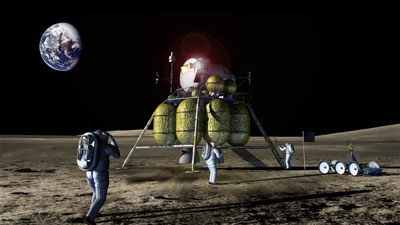Apollo’s scientific bounty gives good reasons to go back to the Moonby Chris Gainor
|
| More than a generation after Apollo, its six expeditions to the lunar surface are routinely derided for being “flags and footprints” missions and little more. |
This lack of appreciation for the rich scientific legacy of Apollo has its roots in the tangled history of lunar science. At the time Apollo 11 landed on the Moon, three major theories for the formation of the Moon competed for support. One held that the Moon was a “sister” body formed simultaneously with the Earth from the cloud of matter that surrounded the young Sun. Another suggested that the Moon was a wayward body that was captured when it passed close to the Earth. And the third theory postulated that the original Earth split into the Earth and the Moon as it spun faster and faster.
Each theory had strengths and weaknesses, and scientists argued passionately about them, sometimes filling television time during coverage of the Apollo missions with their disagreements. The feud between astronomer Gerald P. Kuiper, an advocate of the sister planet theory, and chemist Harold C. Urey, who supported the capture theory, remains the stuff of legend. When the last Apollo astronauts returned home from the Moon in 1972, the arguments were still going strong.
Finally, in October 1984, a meeting of lunar scientists in Kona, Hawaii, reached a consensus on the giant impact theory. This theory had first been proposed in 1946 by Harvard geologist Reginald A. Daly, whose paper was forgotten until after William K. Hartmann and Donald R. Davis of the Planetary Science Institute in Tucson, Arizona, raised the idea again in 1975.
The giant impact theory explained most of the findings that sank the three major theories, including the composition of lunar material, which is similar to but not the same as the Earth, and the peculiarities of the Moon’s motion. New evidence advanced since 1984 has added support to the giant impact theory. While most informed scientists support the theory, the dissenters include Apollo 17 astronaut, Harrison Schmitt, the only professional geologist to have traveled to the Moon.
The news of the scientific agreement around the giant impact theory was slow in reaching the public. Perhaps the first prominent mention of the theory came when Scientific American put it on the cover of its July 1994 issue marking 25 years since Apollo 11. In 2003, the first book aimed at the general public about the giant impact theory was published, The Big Splat, or How Our Moon Came to Be, by Dana Mackenzie.
There are other reasons for the low profile of lunar and other planetary science. The error of Percival Lowell’s prognostications about canals and life on Mars, combined with advances in spectroscopy and photography, led astronomers to cosmology rather than solar system astronomy, a trend that continues to this day.
| It’s time for NASA to talk about how Apollo gave good scientific value, and about the research that needs to be done when astronauts return to the Moon. |
When President John F. Kennedy and Congress decided to send astronauts to the Moon, NASA had to fund the buildup of lunar science to provide a scientific basis for the Apollo lunar landings. During Apollo, many scientists were frustrated by the engineering orientation of the early flights, and many made their feelings very public as NASA shifted to a science focus for the final three Apollo lunar expeditions.
And on top of everything else, it is well known that Apollo was originally designed to beat the Soviet Union to the Moon rather than for scientific study. When Apollo ended, many geologists and others moved away from studies of the Moon to work on other areas, and public interest in lunar exploration went with it.
While the work of Ralph Baldwin, Eugene Shoemaker, and others showed before Apollo that impacts played a more important role in lunar and geologic evolution than most experts believed at the time, it still took the Apollo program to drive the point home. The point was demonstrated most dramatically when Apollo 16 was sent to a landing site with what appeared to be strong evidence of a volcanic history, and came home with proof that impacts formed the area.
Today, the exploration of Mars has more popularity amongst the public and many scientists because of the possibility of life on the Red Planet. So sending astronauts back to the Moon is not an easy sell to taxpayers.
While Apollo helped answer many questions about the early histories of the Moon and the Earth, many more questions remain to be answered, and more exploration of the Moon is needed to get those answers.
It’s time for NASA to talk about how Apollo gave good scientific value, and about the research that needs to be done when astronauts return to the Moon. So far NASA’s approach to the issue may result in that return to the Moon being delayed yet again by skeptical politicians and an uninformed public.
